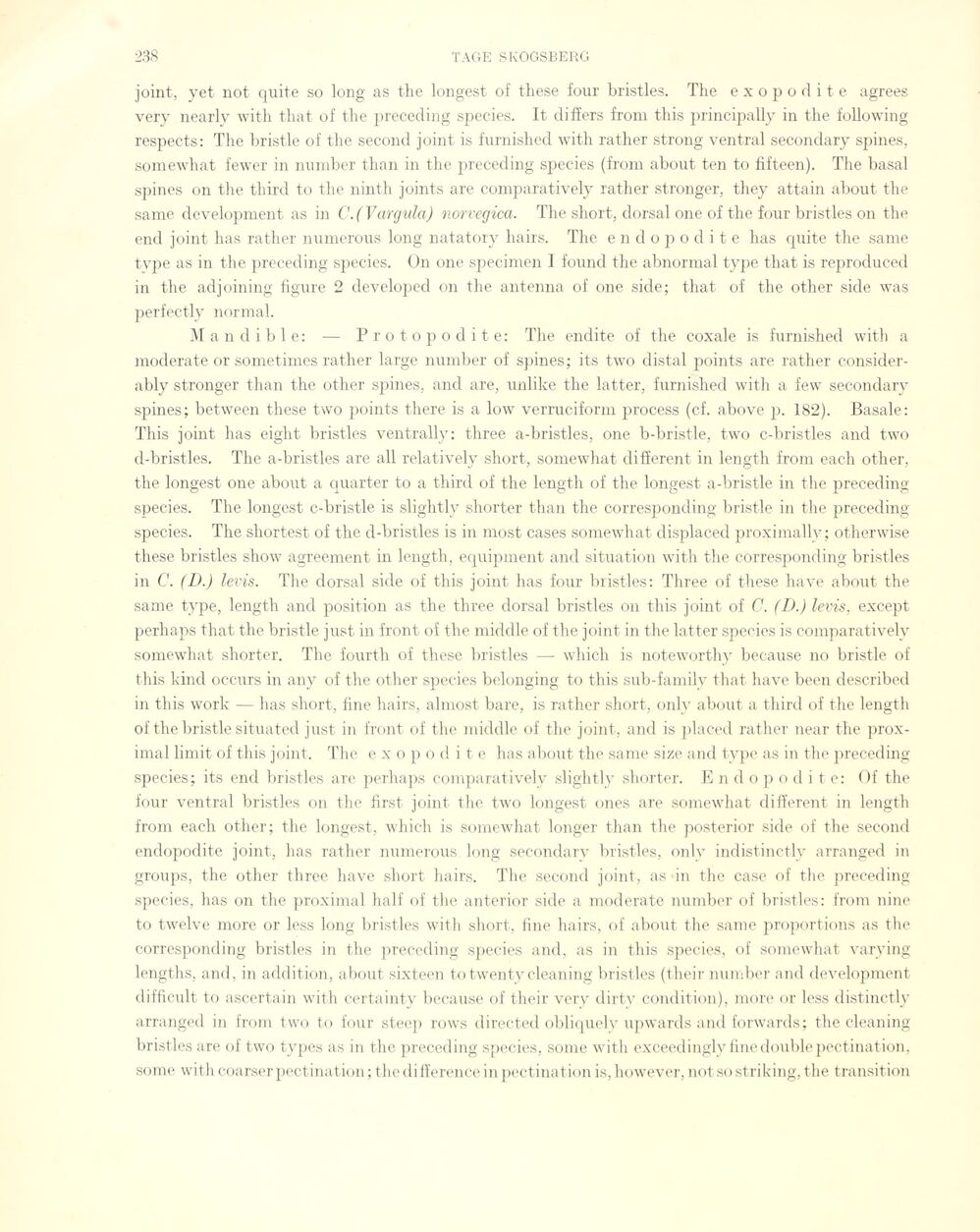
Full resolution (JPEG) - On this page / på denna sida - Sidor ...

<< prev. page << föreg. sida << >> nästa sida >> next page >>
Below is the raw OCR text
from the above scanned image.
Do you see an error? Proofread the page now!
Här nedan syns maskintolkade texten från faksimilbilden ovan.
Ser du något fel? Korrekturläs sidan nu!
This page has never been proofread. / Denna sida har aldrig korrekturlästs.
joint, yet not quite so long as the longest of these four bristles. The esopodite agrees
very nearly with that of the preceding species. It differs from this principally in the folio wing
respects: The bristle of the second joint is furnished with rather strong ventral secondary spines,
somewhat fewer in number than in the preceding species (from about ten to fifteen). The basal
spines on the third to the ninth joints are comparatively rather stronger, they attain about the
same development as in C.(Vargula) norvegica. The short, dorsal one of the four bristles on the
end joint has rather mimerons long natatory hairs. The endop odite has quite the same
tvpe as in the preceding species. On one specimen I found the abnormal type that is reproduced
in the adjoining figure 2 developed on the antenna of one side; that of the other side was
perfectly normal.
Man dible: — Pr o topod i te: The endite of the coxale is furnished with a
moderate or sometimes rather large number of spines; its two distal points are rather
consider-ably stronger than the other spines, and are, unlike the latter, furnished with a few secondary
spines; between these two points there is a low verruciform process (cf. above p. 182). Basale:
This joint has eight bristles ventrally: three a-bristles, one b-bristle, two c-bristles and two
d-bristles. The a-bristles are all relatively short, somewhat different in length from each other,
the longest one about a quarter to a third of the length of the longest a-bristle in the preceding
species. The longest c-bristle is slightly shorter than the corresponding bristle in the preceding
species. The shortest of the d-bristles is in most cases somewhat displaced proximally; otherwise
these bristles show agreement in length, equipment and situation with the corresponding bristles
in C. (I).) levis. The dorsal side of this joint has four bristles: Three of these have about the
same type, length and position as the three dorsal bristles on this joint of C. (D.) levis, except
perhaps that the bristle just in front of the middle of the joint in the latter species is comparatively
somewhat shorter. The fourth of these bristles — which is noteworthy because no bristle of
this kind occurs in any of the other species belonging to this sub-family that have been described
in this work — has short, fine hairs, almost bare, is rather short, only about a third of the length
of the bristle situated just in front of the middle of the joint, and is placed rather near the
proximal limit of this joint. The exopodite has about the same size and type as in the preceding
species; its end bristles are perhaps comparatively slightly shorter. Endopodite: Of the
four ventral bristles on the first joint the two longest ones are somewhat different in length
from each other; the longest, which is somewhat longer than the posterior side of the second
endopodite joint, has rather numerous long secondary bristles, only indistinctly arranged in
groups, the other three have short hairs. The second joint, as in the case of the preceding
species, has on the proximal half of the anterior side a moderate number of bristles: from nine
to twelve more or less long bristles with short, fine hairs, of about the same proportions as the
corresponding bristles in the preceding species and, as in this species, of somewhat varying
lengths, and, in addition, about sixteen to twenty cleaning bristles (tlieir number and development
difficult to ascertain with certainty because of their very dirty condition), more or less distinetly
arranged in from two to four steep rows directed obliquely upwards and forwards ; the cleaning
bristles are of two types as in the preceding species, some with exceedingly fine double pectinati on,
some with coarser pecti nation ; the difference in pectination is, however, not so striking, the transition
<< prev. page << föreg. sida << >> nästa sida >> next page >>